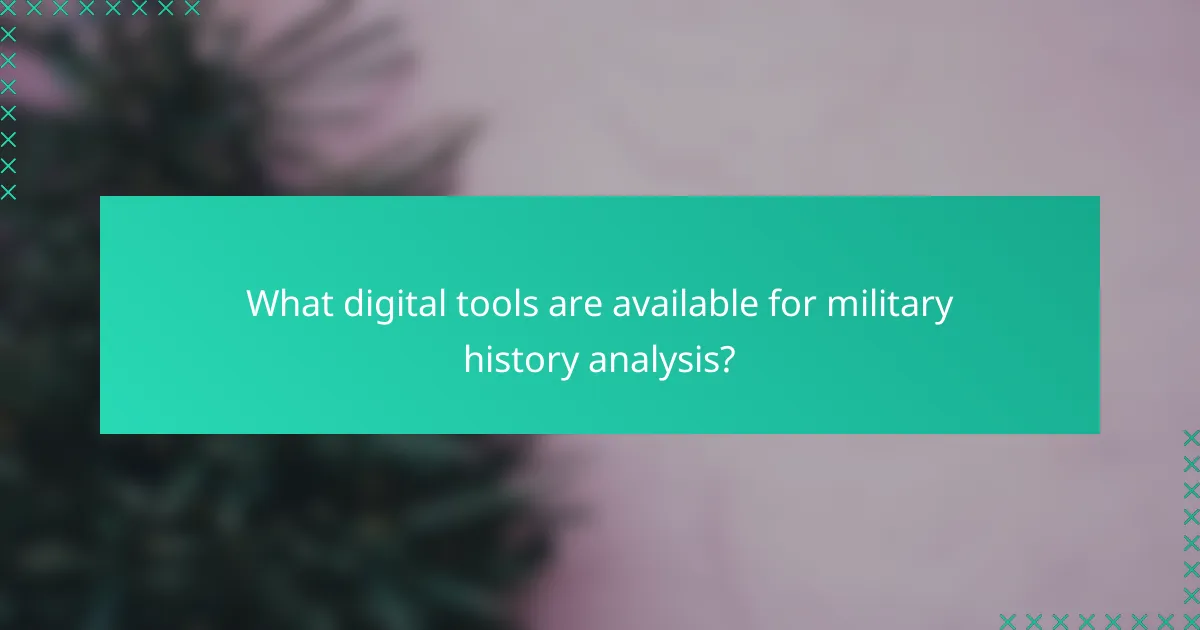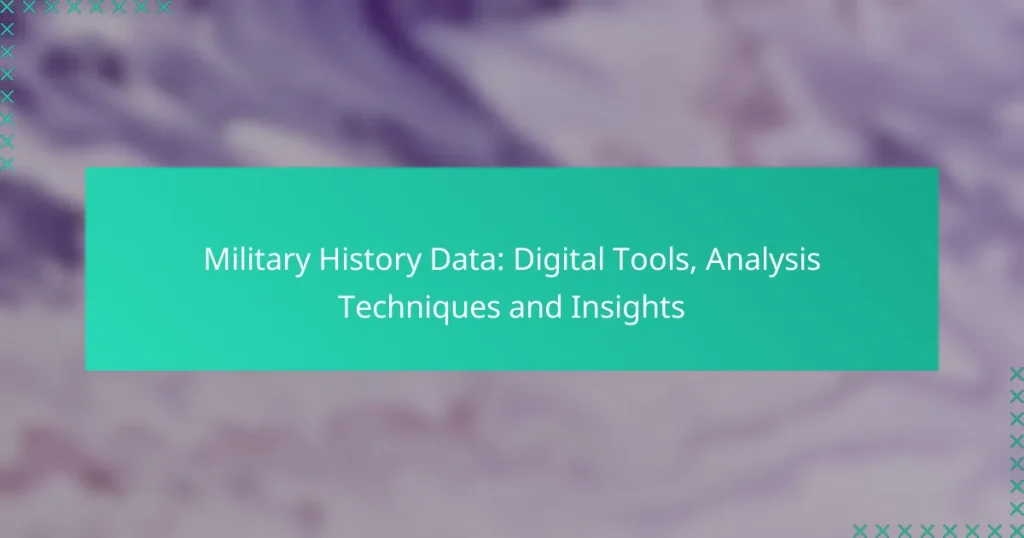Digital tools have revolutionized the field of military history by enabling researchers to analyze complex datasets and visualize historical events effectively. By employing advanced data analysis techniques, such as statistical methods and text mining, historians can uncover patterns and insights that deepen our understanding of warfare and its evolution. This integration of technology and analysis not only enhances research but also informs contemporary military practices and decision-making.

What digital tools are available for military history analysis?
Several digital tools are designed for military history analysis, each offering unique capabilities for data handling, visualization, and research. These tools enable historians and researchers to analyze complex datasets, visualize historical events, and create engaging narratives.
ArcGIS for spatial analysis
ArcGIS is a powerful geographic information system (GIS) that allows users to analyze spatial data related to military history. It enables the mapping of battlefields, troop movements, and logistical routes, providing insights into geographical influences on military outcomes.
Users can create layered maps to visualize different data sets, such as troop locations over time or the impact of terrain on battles. This tool is particularly useful for historians looking to understand the spatial dynamics of conflicts.
Tableau for data visualization
Tableau is a leading data visualization tool that helps military historians present complex data in an accessible format. It allows users to create interactive dashboards that can display trends, comparisons, and patterns in military data.
For example, historians can visualize casualty rates across different wars or analyze the effectiveness of various military strategies. Tableau’s user-friendly interface makes it easy to share findings with a broader audience.
ChronoZoom for timeline creation
ChronoZoom is a timeline creation tool that helps users visualize historical events in a chronological format. This tool is particularly beneficial for military historians who need to illustrate the sequence of events during conflicts.
With ChronoZoom, users can create interactive timelines that include key battles, treaties, and political changes. This visual representation aids in understanding the context and progression of military history.
Military History Online for research
Military History Online is a comprehensive resource for researchers seeking articles, forums, and primary sources related to military history. It serves as a platform for sharing knowledge and connecting with other historians and enthusiasts.
Users can access a wide range of materials, including scholarly articles and personal accounts, which can enhance their understanding of specific events or themes in military history.
Google Earth for geographic context
Google Earth provides a unique way to explore geographic contexts relevant to military history. Users can view satellite imagery and 3D terrain models, which help in understanding the geographical factors that influenced military operations.
For instance, historians can examine the topography of battlefields or the locations of military installations. This tool enhances the analysis by providing a visual context that complements historical data.

How can data analysis techniques enhance military history research?
Data analysis techniques can significantly improve military history research by providing insights into patterns, relationships, and trends that may not be immediately apparent. By leveraging statistical methods, text mining, and network analysis, researchers can uncover deeper understandings of historical events and their implications.
Statistical analysis for trend identification
Statistical analysis allows researchers to identify trends in military history by examining data sets related to battles, troop movements, and casualties. For instance, analyzing casualty rates over time can reveal the impact of specific strategies or technologies on warfare outcomes.
To effectively utilize statistical analysis, researchers should consider employing software tools that can handle large data sets and perform regression analysis or time series analysis. Common pitfalls include relying on small sample sizes or failing to account for confounding variables, which can skew results.
Text mining for document analysis
Text mining involves extracting useful information from large volumes of text, such as military reports, letters, and historical documents. This technique can help researchers identify recurring themes, sentiments, and key figures in military history.
When engaging in text mining, it is crucial to use natural language processing tools that can accurately parse and analyze text. Researchers should be cautious of biases in the source material and ensure a diverse range of documents are included to provide a balanced perspective.
Network analysis for relationship mapping
Network analysis is a powerful method for mapping relationships between individuals, units, and events in military history. By visualizing these connections, researchers can better understand alliances, rivalries, and the flow of information during conflicts.
To conduct effective network analysis, researchers should gather data on key entities and their interactions, then use software tools to create visual representations of these networks. Avoiding overly complex models is essential, as simpler networks often provide clearer insights into historical dynamics.

What insights can be gained from military history data?
Military history data provides valuable insights into the evolution of warfare, strategies, and outcomes of conflicts. By analyzing historical records, researchers can identify trends and correlations that inform current military practices and decision-making.
Patterns in warfare strategies
Analyzing military history data reveals recurring patterns in warfare strategies, such as the use of flanking maneuvers or siege tactics. These patterns can help military strategists understand what has worked in the past and adapt those strategies to modern contexts.
For example, the shift from conventional warfare to asymmetric tactics in recent conflicts illustrates how smaller forces can effectively challenge larger armies. Recognizing these shifts allows for better preparation and response in contemporary military operations.
Impact of technology on military outcomes
Technology has consistently shaped military outcomes throughout history, influencing everything from weaponry to communication. The introduction of gunpowder, for instance, drastically changed battlefield dynamics and tactics.
Today, data analytics, drones, and cyber warfare capabilities are transforming how conflicts are fought. Understanding the historical impact of technology helps military leaders anticipate future developments and integrate new tools effectively.
Socio-political influences on conflicts
Military history data highlights the significant role socio-political factors play in shaping conflicts. Issues such as nationalism, economic conditions, and political alliances often dictate the course of wars and military engagements.
For instance, the socio-political climate leading up to World War I illustrates how alliances and rivalries can escalate tensions. Analyzing these influences helps military historians and strategists understand the broader context of conflicts and develop strategies that consider these factors.

What are the prerequisites for effective military history data analysis?
Effective military history data analysis requires a solid understanding of historical context and familiarity with data analysis software. These prerequisites ensure that analysts can interpret data accurately and derive meaningful insights from historical events.
Understanding of historical context
A deep understanding of historical context is crucial for analyzing military data. Analysts must be aware of the political, social, and economic factors that influenced military decisions and outcomes. This knowledge helps in interpreting data trends and drawing connections between events.
For instance, understanding the impact of World War II on military strategies can provide insights into the effectiveness of certain tactics used during that period. Analysts should consider factors such as alliances, technological advancements, and cultural influences when evaluating data.
Familiarity with data analysis software
Proficiency in data analysis software is essential for effective military history data analysis. Tools such as Excel, R, or Python can help analysts manage large datasets, perform statistical analyses, and visualize results. Familiarity with these tools allows for more efficient data manipulation and interpretation.
Analysts should focus on learning key functionalities like data cleaning, statistical testing, and creating visual representations of data. Common pitfalls include neglecting to validate data sources or misinterpreting statistical results, which can lead to inaccurate conclusions.

How do military historians select the right tools?
Military historians select tools based on their specific research needs, the type of data they are analyzing, and the intended outcomes of their studies. The right tools can enhance data accuracy, streamline analysis, and facilitate insightful conclusions.
Criteria for tool selection
When selecting tools, military historians consider several criteria, including usability, compatibility with existing data formats, and the ability to handle large datasets. Tools should also offer robust analytical capabilities, such as statistical analysis or geographic information system (GIS) features.
Cost is another significant factor; historians often look for tools that provide good value, whether through free software or affordable licenses. Additionally, the availability of support and community resources can influence the decision, as a strong user community can provide assistance and share best practices.
Comparative analysis of tool features
Historians often conduct a comparative analysis of various tools by creating a feature matrix that highlights strengths and weaknesses. For instance, they may compare software based on data visualization options, ease of integration with other systems, and analytical depth.
Some popular tools include ArcGIS for mapping, NVivo for qualitative analysis, and R for statistical computing. Each tool has unique features that cater to different aspects of military history research, making it essential to align tool capabilities with specific project requirements.

What are the emerging trends in military history data analysis?
Emerging trends in military history data analysis include the integration of artificial intelligence and the use of big data to enhance research capabilities. These advancements enable historians to uncover insights from vast datasets, improving the accuracy and depth of military studies.
Integration of AI in historical research
The integration of AI in historical research allows for the analysis of large volumes of military data quickly and efficiently. Machine learning algorithms can identify patterns and correlations that might be missed by traditional methods, providing new perspectives on historical events.
For instance, AI can assist in analyzing battle reports, troop movements, and logistical data, helping historians to reconstruct events with greater precision. Utilizing natural language processing, researchers can also sift through extensive archives of documents to extract relevant information, significantly reducing the time needed for manual analysis.
Use of big data for comprehensive studies
Big data enables comprehensive studies of military history by aggregating information from diverse sources, such as satellite imagery, social media, and historical records. This multifaceted approach allows for a more holistic understanding of military conflicts and their impacts.
Historians can leverage big data analytics to visualize trends over time, such as changes in military strategies or the socio-economic effects of wars. By employing data visualization tools, researchers can present their findings in an accessible manner, making complex data easier to interpret and share with a broader audience.


